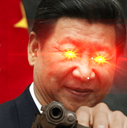Non-archive: https://www.nytimes.com/2025/04/21/world/asia/china-tariffs-trade-warning.html
This is actually some interesting strategy from the US. Rather than trying to actually reindustrialise the USA itself, they could move their offshore labour to some other aspiring third world country. The carrot of becoming a “Second China” against the stick of suffering sanctions could be enough to convince some massive country like the Philippines to also embargo China.
They can also extract more surplus than corporations in China due to less labour regulation and class struggle.
Vietnam seems like a prime candidate to become to China what China was to the USSR in the 70s. Despite statements of solidarity and friendship, they can easily fill China’s niche in the world market.
Ironically, this competition between the old economic bloc and the nascent Chinese one could lead to industrialisation efforts in the periphery of both.
I’m not as positive on China as most users here, so I see a clear incentive for Chinese capital to invest in dependent primary sector development at the periphery of their bloc, as investing in advanced manufacturing is both competition in their own bloc and creating a replacement for the NATO bloc. On the other hand, any “second China” can’t be held down economically, so it’ll need a tighter leash through military dependence by surrounding them with war.
My candidates for those besides the usual Europe, Israel and Japan are Chile, Philippines, Vietnam and possibly even occupied and reconstructed Ukraine after the war.
You should check how much of inputs in Vietnam comes from China (while yes, the majority of the outputs goes to the USA), and how much of their manufacturing force have Chinese companies at the core and Chinese supply lines. Also, how much they rely on China for required infrastructure, including how much electricity is currently supplied from Nanning.
Vietnam has potential, but that potential can only be capitalized if it aims to grow alongside a prosperous China.
The Philippines will need some type of revolution, drastically upgraded infrastructure, drastically improved education for its people. Their political structure is basically unchanged for centuries, with a couple of dynastic ruling families and as yet, a population unready for the structured existence of industrialization and manufacturing.
I agree that the world isn’t going to rise up in a united front with China against the US. China (and certainly the CPC) doesn’t expect that, although they do what they can to engage with the global south simply as part of an unchanging decades long strategy. For the CPC, Trump is short term phenomenon reflecting the same long term trend from USA that they always knew they will have to deal with at some point. Although they were probably hoping they wouldn’t have to deal with it quite so quickly.
The rhetoric in the West is really different from the news and analysis in Chinese. It’s calmer and always tend to take the long perspective, small adjustments required but the direction of travel remains steady. Working with neighboring countries is a part of consistent and ongoing relationship-building. While one may leverage the current volatility to get some stuff done, China does not expect miracles. Its confidence comes from know it has the ability to weather these external fluctuations within itself, and when push comes to shove, it can never and will not rely on any other entity.
It’s not that easy to just make a “second China”. Because what made China China wasn’t just cheap labor costs, it was the entire foundation built during the Mao era. Even India with its similarly large population size as the other comment here suggests can’t just replace China overnight. If they could they would have done so already.
But India is pursuing a fundamentally different model of economic development and the US can’t magically transform it with just their “carrot and stick method” that you mention. They would need not just to invest massively in a kind of Marshall plan style without immediate prospects for a return on that investment, which US capital is not going to be easily persuaded to do, but also change the entrenched oligarchic and political structures in India that stand in the way of China style industrial development.
And India is where the US’s chances are highest. In South East Asia they stand even less of a chance, countries like Vietnam, Indonesia, Malaysia, they are much more highly integrated into China’s economic orbit. And yes, the Philippines is a US neocolony that can serve as a military launchpad, but they definitely can’t economically replace China. I think if the US imperialists really are thinking along the lines you laid out they are severely deluding themselves.
Do you have any idea how many more people China has compared to Vietnam? Land mass? Territorial waters? Natural resources?
That’s not even considering how ideologically communist Vietnam is.
No, the only viable junior China is India right now.
But the US isn’t looking for a junior China in the third world. They are looking to Canada, Mexico, and Europe as a portfolio play to replace China. They also plan to use South American third world countries for natural resources extraction. The US converting India to junior China while losing Brazil to the Chinese sphere of influence would still be devastating for the USA. The USA is looking for lebensraum.
There’s no way they’ll get that from any SE Asian country.
Brazil is distancing itself from China at such a fast pace that some analysts are predicting it’ll leave BRICS after a right wing victory in the next election.
Do you have any idea how many more people China has compared to Vietnam?
Yes, 14 times. I’m not saying it is going to be easy or that it’ll be concentrated on a single country like it was with China. In fact, I believe that some fragmentation will be optimal to prevent China 2 from just doing what China did.
The USA is looking for lebensraum.
The US doesn’t need Lebensraum because they already have colonies and barely any national industry. Incorporating Canada and subduing Mexico for geopolitical reasons aren’t incompatible with trying to replace China in the international division of labour.
Surplus value must be extracted from somewhere, and although Mexico and Canada have their industries it’ll not be enough and too close to home to be too heavy handed.
That’s not even considering how ideologically communist Vietnam is.
China, Vietnam and the USSR were all nominally communists when Kissinger was playing the three of them against each other. The superstructure follows the base, and unless both countries integrate their economies or at least make SolidNet into a proper successor to the Third International, I won’t hold my breath. Right now the CPV is already negotiating zero tariffs with the US.
The only countries I would seriously bet on staying with China are Venezuela, Iran, Russia, the DPRK and Cuba, and possibly the AES. And that’s just because they are so economically desintegrated from the world economy that they have nothing to lose and everything to gain, for both their proletariat and (if it exists) their bourgeoisie.
Brazil is distancing itself from China at such a fast pace that some analysts are predicting it’ll leave BRICS after a right wing victory in the next election.


